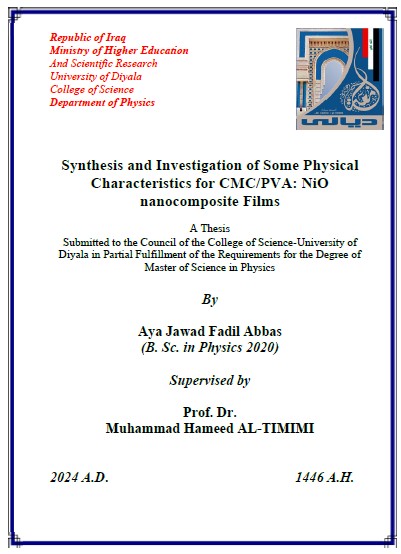Abstract
In this study, nickel oxide nanoparticles (NiO NPs) were prepared using the chemical precipitation method, known for its simplicity, low cost, and non-toxic nature in synthesizing high-crystalline and pure nanoparticles. Additionally, polymer blend films of Carboxymethyl Cellulose (CMC) and Polyvinyl Alcohol (PVA) in a ratio of (CMC 50% – PVA 50%) were prepared both in pure form and reinforced with nickel oxide (NiO) nanoparticles (NPs) using the solution casting method. Subsequently, the impact of calcination temperature was investigated at different temperatures (400, 600 and 800)°C, followed by the examination of adding NiO nanoparticles prepared at a calcination temperature of 800°C and various weight ratios (3, 5, 7, 9) % wt on the structural, optical, electrical, and thermal properties of the CMC-PVA polymer blend films.
The results of thermo gravimetric analysis (TGA) showed that most of the reactive materials involved in the preparation of NiO NPs nanoparticles vaporize at temperatures above 720°C. X-ray diffraction (XRD) analysis revealed a polycrystalline structure with a dominant orientation along the (002) direction., and with increasing temperatures, crystallinity, crystal size, and particle size grew at 600°C and 800°C during calcination. On the other hand, scanning electron microscopy (FE-SEM) revealed the formation of regular clusters and aggregates dispersed uniformly in the polymer films. The results of the infrared spectroscopy (FTIR) revealed a strong interaction between the prepared nickel oxide particles and the nanocomposite polymer blend (CMC-PVA) within the overlaid polymeric films.
Observations within the optical measurements fell within the wavelength range of nm (1100-190). Introducing nano-sized nickel oxide particles into the polymer blend (CMC-PVA) resulted in a decrease in transmittance, which increased with higher nanoparticle ratios. Transmittance decreased with longer wavelengths, while reflectance increased with the addition and increment of nano-sized particles. Reflectance decreased with longer incident light wavelengths. The absorption coefficient of the films increased with the rise in NiO NPs nanoparticle ratio. Furthermore, the energy band gap values of the polymer films decreased with the addition of nanoparticles and an increase in nanoparticle ratio. Notably, the energy band gap values for both pure and nanoparticle-reinforced (CMC-PVA) films were sequentially (4.99, 4.88, 4.54, 4.43, 3.99) eV. The (CMC-PVA: NiO-9% wt) film achieved the lowest energy band gap value. Moreover, the dielectric constant’s refractive index, extinction coefficient, and real and imaginary parts increased with NiO nanoparticles and increasing nanoparticle ratio.
Regarding the electrical properties, the alternating electrical conductivity of the prepared films increased with the addition of NiO nanoparticles, increasing nanoparticle ratio, and applied electric field frequency. However, the dielectric constant increased with increasing nanoparticle ratio but decreased with increasing frequency. Additionally, the dielectric loss factor of the prepared films decreased with the addition of nanoparticles and increasing nanoparticle ratio and frequency.
A study also demonstrated the impact of adding nano-sized nickel oxide (NiO) particles and increasing the particle ratio on the thermal conductivity of the prepared membranes. It revealed that the thermal conductivity coefficient values significantly increased upon the addition of nano-sized particles to the polymer blend, along with an escalation in the nanoparticle ratio. The membrane (CMC-PVA) reinforced with nickel oxide particles at a ratio of 9% by weight, calcined at a temperature of 800°C, achieved the highest thermal conductivity coefficient value of (1.44681E-6 W/m2.K).





